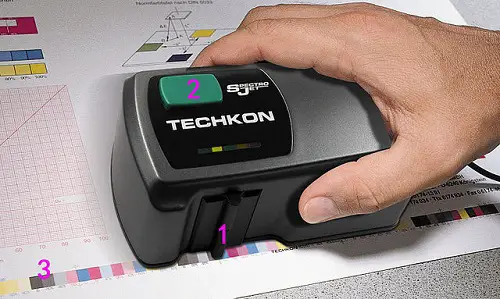
The light we see is just the small part of the electromagnetic spectrum that the human eye is capable of sensing. This is called visible light. When visible light is reflected from an object and touches the sensors in our eyes, we can see the colors of that respective object. During that reflection, while some colors are adsorbed, others are reflected. The colors that are reflected are the colors that we see with the human eye. Color and light form part of our everyday lives. Its presence is everywhere and it affects our emotions, beliefs, and even our conscious and unconscious reactions [1]. While our personal perceptions of different shades of colors will differ, the use of color measurements via instruments goes further than those perceptions and limitations of the human eye. It allows us to analyse and interpret color through the use of objective and analytical data. This in turn creates a standard language of communication that can be used within industries and organizations around the world.
Many biochemical experiments require the measurements of a compound or group of compounds that may be present in a complex mixture. Spectrophotometry and colorimetry techniques identify molecules based on their absorption and emission properties. Colorimetry is one of the most commonly used methods for determining the concentration of these compounds. This method makes use of the property that when white light passes through a colored solution, some wavelengths are absorbed more than others. While molecules may not necessarily have a specific color, these compounds can be reacted with a chemical solution to generate a colored compound made from the initial molecule itself. These generated colored compounds can then be used in spectrophotometry and colorimetry analyses for subsequent identification purposes [3].
Understanding the various types of instruments available for measuring color is imperative when choosing the correct instrument to use for various applications [2]. Two commonly used instruments for measuring color are colorimeters and spectrophotometers. Both these instruments use sophisticated technology to quantify and define color. Despite having many similarities, these instruments each have their own advantages and unique qualities that make one more suitable than the other for a certain type of measurement. As the name suggests, a spectrophotometer is a combination of a spectrometer and a photometer and usually consists of a light source, absorption cell, and detector [1]. The spectrometer portion creates waves of a specific wavelength that are then passed through the test sample and placed in a cuvette. The photometer portion then detects the transmitted waves from the sample in order to calculate the transmittance of the substance. A wavelength isolation device, known as a monochromator, is utilised together with a prism or grating-based wavelength system to isolate single wavelengths or a narrow band of wavelengths. The beam of the light source initially passes through the prism to the sample, which is held in a cell or cuvette. The transmitted intensity is then measured by the detector [4]. A colorimeter, on the other hand, is used for measuring the absorption of a particular color by a substance when light passes through it. In a colorimeter, a low filament lamp is generally used as a light source. There are also a set of color filters present. The filters are chosen depending on the type of sample being analysed. The sample is usually placed in a cuvette, and the detector of the colorimeter determines the amount of light being transmitted through the sample. The output is generally given on a digital display [3].
The major differences between spectrophotometers and colorimeters are outlined below:
- Colorimeters generally perform a psychophysical analysis on samples, while spectrophotometers perform a physical analysis. Psychophysical sample analyses involve mimicking the human eye-to-brain perceptions so that the device displays color in the same way that the human eye would see it. Physical sample analyses allow for analysis of the reflection, adsorption, and transmission properties of a sample. Spectrophotometers also provide a full wavelength spectrum analysis of the sample’s properties thereby producing data that goes beyond that which is commonly observed by the human eye. In addition, spectrophotometers can also be used to calculate the psychophysical information generally obtained with colorimeters, providing more in-depth information and more versatility than that provided by colorimeters.
- Colorimeters generally consist of a sensor and simple data processor, while a spectrophotometer consists of a sensor, data processor, and a computer with software to produce data.
- Colorimeters are known to isolate a broad band of wavelengths using a tristimulus absorption filter. Band filters are used to separate light into respective color components and then to matc the respective color components to that seen by the human eye. This results in the production of a one or three value color space. Spectrophotometric instruments, on the other hand, break up light into a narrow band of wavelengths using a prism or color grating system. This is followed by an array of sensors that read each section of the spectrum resulting in the production of spectral data.
- Colorimeters work better for routine comparisons of similar colors and for the adjustments of small color differences under constant conditions. Spectrophotometers, on the other hand, work well for color formulation and color developments.
- Colorimeters are generally used for quality control and inspection purposes, while spectrophotometers can be used for both quality inspection and research and development.
- It is more cost effective to purchase a colorimeter as offered at a comparatively lower prices than spectrophotometers; however, the decision to purchase should also be dependent on the applications of the instruments.
- Colorimeters are smaller, more mobile, and more compact in size while offering simple ease of operation. Spectrophotometers, on the other hand, offer more in-depth analysis and are more versatile with the type of analyses offered. They are more suited for complex color analyses and allow for the determination of spectral reflection at different wavelengths.
- Colorimeters are generally used in production and inspection industries, while spectrophotometers are often used in laboratories and research and development applications.
- A colorimeter quantifies color by measuring the three primary color components of light, which are red, blue, and green. A spectrophotometer measures the actual color within the human visible light wavelength [3].
- Colorimeters use fixed wavelengths in the visible range only, while spectrophotometry uses a wider range of wavelengths in the ultraviolet, visible, and infrared zones [3].
- Colorimeters measure the absorbance of light, while spectrophotometers measure the amount of light that passes through a sample [3].
- Colorimeters are not able to identify colorant strength or metamerisms, which are defined as differences in the reflection curves between two colors that look the same under a given form of light. They also cannot be used under variable illuminating conditions. Spectrophotometers are more versatile and can be used under multiple illuminating conditions. They are capable of measuring metamerisms and can identify color strengths.
- Colorimeters are ideally used for straightforward color measurements and for comparison or matching purposes that can aid human visual responses. They do not, however, give information about data that is invisible to the human eye. Spectrophotometric instruments are ideally used for in-depth analyses of scientific devices. They are commonly used in color formulation studies, in color system developments, and quality control areas throughout production. They can be used in the identification and quantification of inorganic compounds as well as organic and complex biochemical molecules.
- Colorimeters rely on the principle that absorbance of a substance is proportional to its concentration. This means that a more concentrated solution will give a higher absorbance reading. Spectrophotometers allow for a full spectrum analysis, which then allows for greater specificity and identification of color differences that are usually missed by colorimeters.
Table 1: Summary of the differences between colorimeters and spectrophotometers.
| COLORIMETERS | SPECTROPHOTOMETERS |
| Can perform psychophysical analyses
|
Can perform physical analyses |
| Consists of a sensor and simple data processor | Consists of a sensor, data processor, and computer software |
|
Data is displayed on a digital or analogue output |
Data is produced and recorded via computer software |
|
Can isolate broad bands of wavelengths |
Can break up light into a narrow band of wavelengths |
|
Applications include: 1) routine comparisons of similar colors and 2) adjustment of small color differences |
Applications include: 1) color formulations and 2) color developments |
|
More cost effective |
More expensive |
|
Smaller, more mobile, and compact |
Larger and less mobile |
|
Used in production and inspection industries, like the paint or printing industries |
Used in laboratories and for research and development |
|
Quantifies color by measuring the three primary color components of light |
Measures the actual color within the human visible light wavelength |
|
Uses fixed wavelengths, which are in the visible region only |
Uses a wider range of wavelengths in the ultraviolet, visible, and infrared regions |
|
Measures the absorbance of light |
Measures the amount of light that passes through a sample |
|
Cannot identify color strengths or metamerisms |
Can identify color strengths and metamerisms |
|
Cannot be used under variable illuminating conditions |
Can be used under variable illuminating conditions |
|
Only provides data that is visible to the human eye |
Provides data that may not always be visible to the human eye |
|
Can be used to determine the concentration of an individual compound based on the amout of absorbance |
Can be used in identification and quantification studies of inorganic and organic biochemical molecules |










